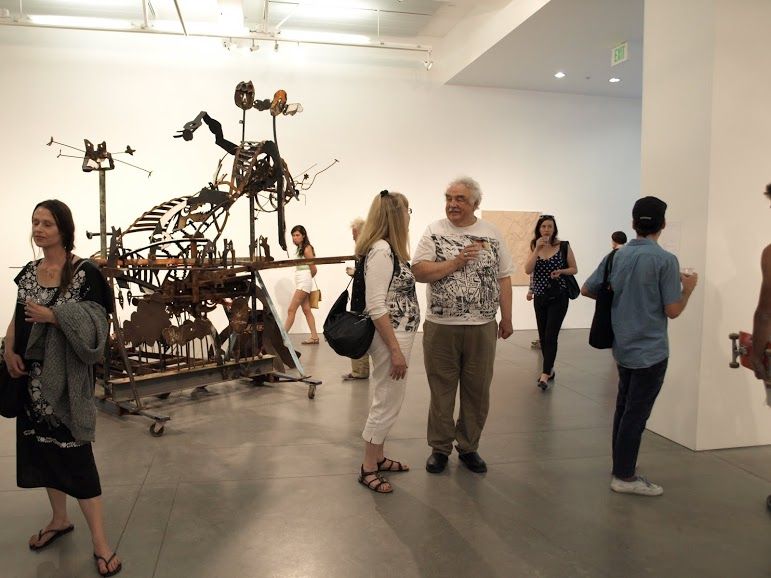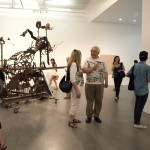INTERVIEW WITH BRIDGET BECK - A NEW KIND OF SCULPTURE
Bridget Beck is an artist whose work is defined not only by her finished piece, but by the creative process she pursues within each sculpture. Bridget has perfected the idea of community art – she involves the community in her artistic endeavors whenever she sees a possibility for it. For instance, she included paintings in one sculpture done by men and women living in a senior home. Her art is interactive and vibrant. It is an experience as much as it is a product of her work. Bridget’s sculptures emulate the passion she has for people through their interactive and collaborative quality – they also are just simply fun. She spent time interning at the Franconia Sculpture Park of Minnesota and later became a resident artist. She has also received a BA in English and Art, an AS in geomatics (civil engineering), and she is now finishing up graduate school at UCLA. Here’s her YouTube Video to show you more about her work. CLICK HERE
First off, thank you so much for offering us some insight into your work. Can you tell us a little bit about yourself? (your childhood, your inspiration, etc).
I grew up in South Dakota in a large very imaginative family. My mom was an amazing storyteller and my parents were very supportive of all of my siblings and I in whatever we became interested in. I was involved in lots of activities but never really tried art until college. When I did finally make sculpture, the hours passed super fast and I was eager to learn how to build and weld things. I had a good friend in college convince me to become an Art major as well as concentrate on an English degree. I had great teachers in college and after. After I left college, I had an internship at a sculpture park in Minnesota called Franconia Sculpture Park. It was there that I knew there was no turning back.
How would you best describe your sculptures?
My sculptures are very intimate and flawed because I am in direct contact with my materials. They show evidence of a personal physical struggle and my imaginings are in constant communication with the viewer. This conversation posits drudgery and play in a cosmology of opposites. I am interested in the inherent beauty of a junky world where I embrace used and labored bits and pieces that have a value that is overlooked. The movement of the viewer around the form is as important as the narrative tone. The social context is as important as concretely defining personal fantasy.

Bridget Beck
Where does your initial spark of inspiration come from? Are you inspired by shape? By a piece of “junk” you find?
Lately, my drawings have been inspiring my sculptures. They act as a vehicle searching for possibilities unspeakable in terms of a constructed three-dimensional form. The drawings test the water for the new uses of materials to be created into sculpture. The ink urges the sculpture on to new and interesting places. The shapes and unique pieces of ‘junk’ are more inspiring while I am actually deep into building the sculptures… they often don’t affect the larger ideas before I begin.
How is “community collaboration” incorporated in your artistic endeavors?
I want the viewer to know me through the work. I also want to know the viewer better with the artwork acting as a vehicle for this development. I work in several separate traditions bridging the confines of fine art practices because my work is not just for those who regularly visit art galleries or those who can afford to purchase art. I think that in order for art to be a larger part of communities you have to include the community. It just makes a lot of sense to me.
When did you start to include the community into your work? Has this always been a goal of yours or has your work evolved into a work that includes this ideal?
Community has almost always been part of my larger sculptural work. It seems that I have always been inviting them to touch or participate with my sculptures because they almost all have architectural elements. The first interactive sculpture I officially made was a huge and awkward raft made of steel pipes that had swings and places to sit and fish. The earlier work was all my own doing… the later work is where I asked people from the communities I was in to actually help make parts of the sculptures. It honestly wasn’t a goal or an ideal…. it was all a very natural evolution to make sculpture that was a larger part of people’s lives.

Bridget Beck
What sculpture has had the most personal meaning to you?
The Will Be Sculpture has been very close to me lately. My friends and family helped to make this possible through a Kickstarter Campaign. It wouldn’t have happened without them. This sculpture was made collaboratively with a group of teens in South Dakota and also a group of teens in Los Angeles. I raised enough to fly seven of the teens from South Dakota to Los Angeles for the sculptures opening at UCLA. It was so much fun showing them the ocean for the first time. They ran straight for it.
Where do you to find the “junk” you use in your sculptures?
Everywhere I can. I have a big truck and I am always on the lookout for a great deal. I often make friends with the guys in the scrap yards. Steel is like diamonds and rubies to me.
Do you approach your sculptures with the motivation of interaction? Interaction in the sense that the sculpture will be “interactive” once it is created.
Yes, I begin with a conversation or interaction with the community in mind. It is only now that I am making more autonomous work.
What are some of your favorite materials to work with?
I love working with old steel tanks and curved pieces of metal. If I had more resources I would love to work with an old locomotive or submarine.
Are you currently working on any projects?
I just finished my thesis show for my MFA at UCLA. I made three large sculptures that had a narrative between them. I am now resting my muscles for a few weeks and am trying to iron out some details with the Will Be Sculpture and the Poetry Studio. They are both going to be installed in new places soon. I also have been dreaming up some community projects with some of the artists that I have met recently. I always am working on something.
What would you say to an aspiring artist?
It takes a while to learn how to use new tools. When I was just starting out- I was easily discouraged by others who were bothered to help me learn how to use the tools properly. You have to remember that you are going to make mistakes and that is OK! Don’t be too hard on yourself and a good work ethic is worth a mint.
To learn more about Bridget and her work, visit her website.
Recent Posts
-
How to Choose the Perfect Painting for Your Home or Office
When it comes to decorating your space, choosing the perfect painting can be a game-changer. A well- …7th Feb 2025 -
How Post Lights Improve Home Security and Safety
How Post Lights Improve Home Security and SafetyWhen it comes to securing your home and enhancing sa …9th Jan 2025 -
The Best LED Gooseneck Barn Lights for Different Architectural Styles
When it comes to outdoor lighting, barn gooseneck lights are a timeless classic. Their vintage cha …12th Dec 2024




